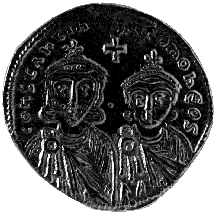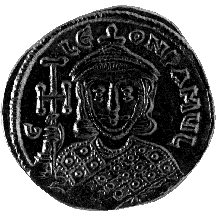



(141) Constantine V and Leo IV - AV solidus, A.D. 751-775, 4.47
g. (inv. 91.282).
Obverse: Facing busts of Constantine V on l. and Leo IV on r., each wearing
chlamys and crown with cross; pellet between heads, cross above;
CONSTANTINOS S LEON O NEOS: Constantine and Leo junior.
Reverse: Facing bust of Leo III, wearing loros and crown with cross
and holding cross
potent on base in r.; D(OMINVS) LEON P(ERPETVVS) A(VGVSTVS) MVL(TOS ANNOS):
Lord Leo, perpetual Augustus, many years.
Provenance: Hesperia Art, 1959.
Bibliography: P. Grierson, Byzantine Coins (London 1982).
The coinage of Constantine V and his immediate successors was characterized
by types proclaiming the continuity of their dynasty, the Isaurian, which
lasted until the end of the century. Constantine had been co-emperor with
his father Leo III until he was made sole emperor upon Leo's death in A.D.
741. Ten years later he made his own son, Leo IV, co-emperor. In Constantine's
late coinage the entire family is depicted, with the co-emperors on the
obverse and the founder of their dynasty on the reverse. The heads are almost
identical, with the exception of Leo IV's clean-shaven face, and the conventions
of rank obscure even their most well-known features; over the objections
of the Church, Constantine wore no beard, but he is depicted with a beard
on the coin to indicate his seniority.
Constantine's father, Leo III, had forbidden the veneration of icons, which
had become widespread in the East, and this began an internal struggle between
the iconoclasts, or destroyers of icons, and the iconodules, or worshippers
of icons, which lasted for over a century. The controversy reached its height
in the reign of Constantine V with the violent destruction of religious
images and the persecution of those who favored them. Secular images replaced
religious images, and the cross on the steps was replaced by imperial portraits.
R.K.B.



All contents copyright (c) 1996.
Lawrence University
All rights reserved.